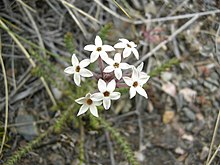| Arjona patagonica | |
|---|---|
 | |
| Scientific classification | |
| Kingdom: | Plantae |
| Clade: | Tracheophytes |
| Clade: | Angiosperms |
| Clade: | Eudicots |
| Order: | Santalales |
| Family: | Schoepfiaceae |
| Genus: | Arjona |
| Species: | A. patagonica |
| Binomial name | |
| Arjona patagonica | |
| Synonyms [2] | |
Arjona patagonica is a species of flowering plant in the family Schoepfiaceae native to southern South America. [3]
